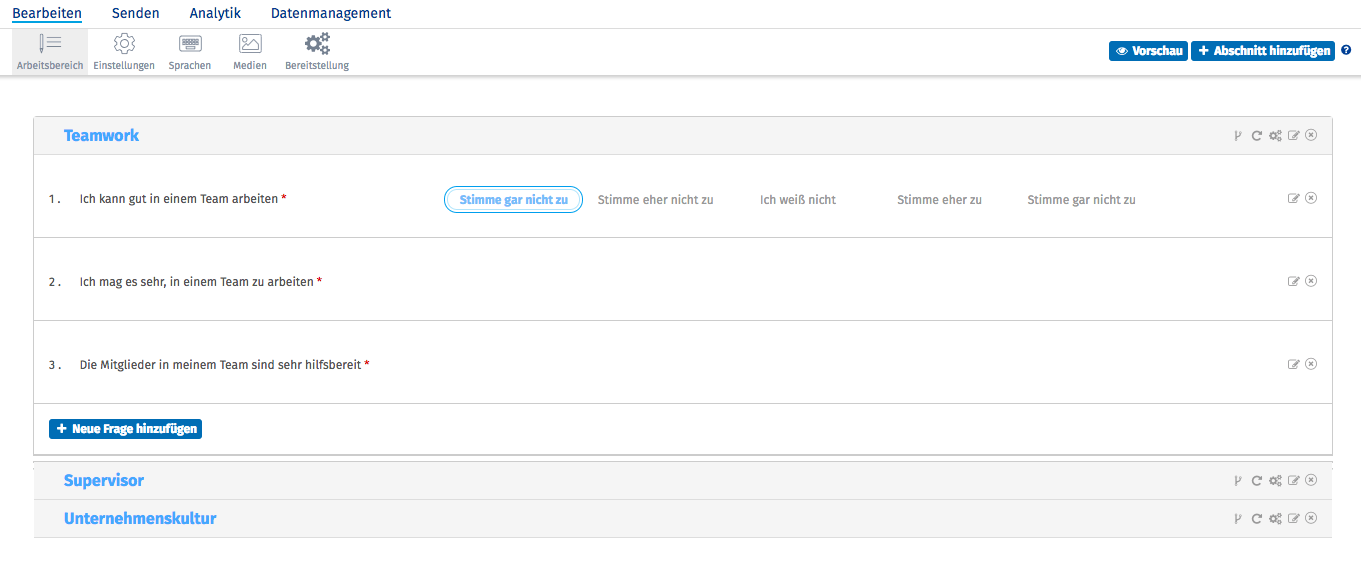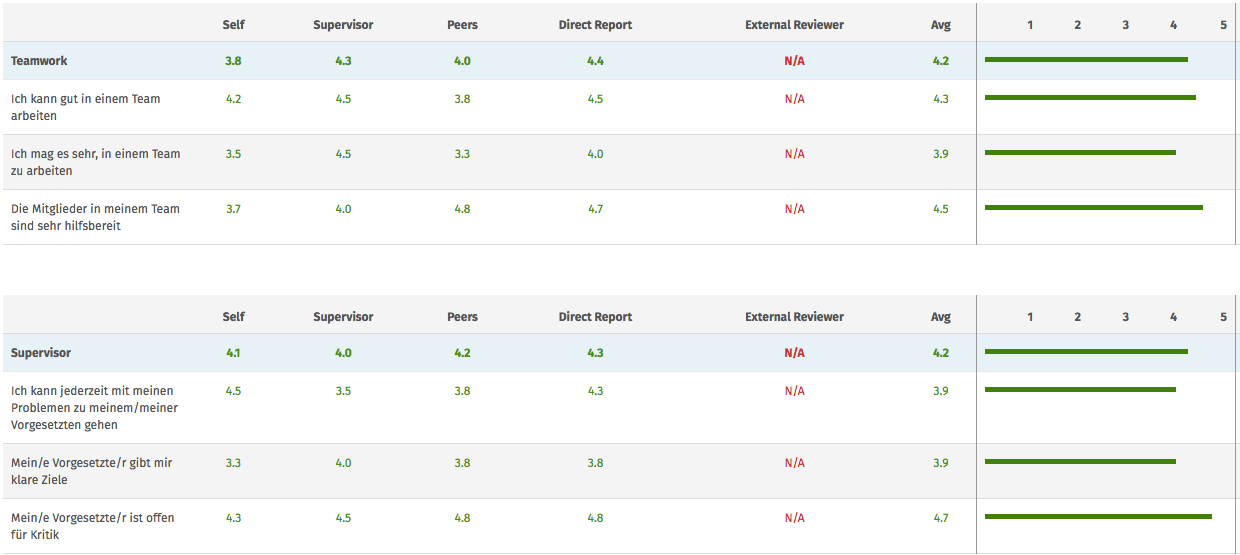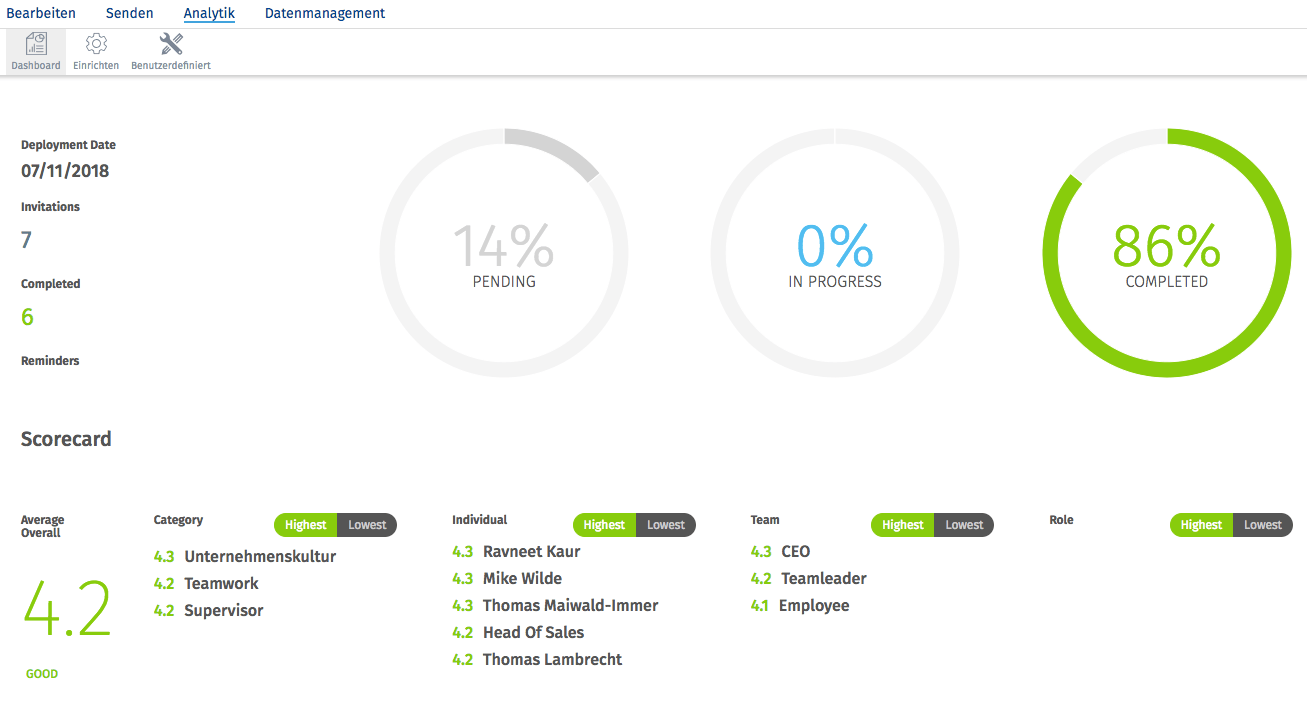Employee Experience Management
360 degree feedback reviews with QuestionPro's employee experience platform provide you with insights from your specialists and managers in real time, quickly, easily and cost-effectively!
Conduct 360 degree feedback surveys
- 1 What is a 360 degree feedback survey?
- 2 What is the purpose of 360 degree feedback?
- 3 360 degree feedback survey: Advantages of conducting it with QuestionPro
- 4 360 degree feedback vs. traditional feedback
- 5 Examples of questions for a 360 degree feedback survey
- 6 It's that easy - create, conduct and evaluate 360 degree feedback surveys with QuestionPro.
- 7 Create and distribute questionnaires
- 8 Analysis: Evaluation of your survey
- 9 1:1 live online presentation 360 degree feedback Conduct surveys with QuestionPro
- 10 Try 360 degree feedback software now for free for 10 days.
What is a 360 degree feedback survey?
Definition
360 degree feedback (360° feedback) is a review method for recording and assessing the performance and technical and social skills of specialists and managers. The aim is to become aware of your own strengths and weaknesses through self- and external assessment. The method involves interviewing virtually all people who have points of contact with the corresponding “feedback recipients” (the person being assessed). In addition to superiors, colleagues and subordinate employees, “feedback providers” (the people making the assessment) can also be customers and suppliers of the company, provided they have sufficient insight into the behavior and competence of the feedback recipient.
360 degree feedback = external assessment + self-assessment
The special thing about the 360 degree survey is that, in addition to the assessment by those giving feedback (external image), the feedback recipient also assesses and evaluates themselves (self-image). Strengths and weaknesses are taken into account equally. The 360 degree feedback is a realistic strengths and weaknesses analysis based on self-image and external assessment. The method is now recognized and practiced worldwide and gives your employees constructive feedback and the opportunity to work on improving their skills through training and other relevant means.
Anonymous surveys ensure more honest answers and a high level of acceptance
The surveys of feedback providers as part of 360 degree feedback are generally carried out anonymously. The result is a more open and honest assessment of the feedback recipient. If one could draw conclusions about the identity of those giving feedback, it would be feared that they would respond according to the principle of social desirability, for example in order not to suffer disadvantages or to make themselves popular. QuestionPro offers you the option of completely anonymizing the feedback survey and thus ensures a high level of acceptance!
360 degree feedback requires feedback to the feedback recipient
Of course, it is not always easy to face third-party evaluations and deal with any negative reviews. Therefore, 360 degree feedback surveys and assessments are usually or at least often carried out with the support of experienced coaches who have specialized in this field and also discuss the results together with the feedback recipient. This also involves designing a personal development plan, with the aim of reducing weaknesses and expanding strengths.
360 degree feedback assessment: sketch of the process
- At the beginning you define the goals of your 360 degree feedback survey
- Think about who can give feedback: colleagues, superiors, customers, suppliers…
- Derive the questions from the goals and create the questionnaire
- The feedback recipient carries out a self-assessment
- Distribute the questionnaire to all feedback providers and carry out the survey
- Evaluation and analysis of the data obtained
- Feedback discussion with the feedback recipient
- Definition of goals and measures for implementation
- Regular evaluation of the defined measures
What is the purpose of 360 degree feedback?
1. If your managers are supposed to conduct a performance review, classic employee feedback only provides one-dimensional insights. Because a 360-degree feedback questionnaire includes information from others as well as the employee themselves, it can be a good starting point for performance reviews.
2. Feedback allows an organization to implement a multi-level evaluation system for its employees. This feedback system enables superiors as well as colleagues and other interest groups to give comprehensive, all-round feedback.
3. In an organization, teamwork is essential and 360-degree feedback can prove extremely useful to measure teamwork. Employees learn about their strengths and weaknesses from the perspective of others. After receiving feedback, employees can work to address the gaps or weaknesses.
4. Feedback must remain anonymous. The survey must not lead to a rift between employees and their colleagues or superiors. This system is designed to improve employees and not to create problems between team members.
360 degree feedback survey: Advantages of conducting it with QuestionPro
1. 360 degree feedback helps you increase self-confidence: This feedback tool helps improve employees' self-awareness. Since this is an anonymous feedback process, honest feedback on an employee's behavior is usually recorded. Employees can go through the feedback and mark the areas where they would like to improve.
2. Reduces blind spots: As the name suggests, 360 degree feedback is a comprehensive feedback method that can be used to analyse strengths and weaknesses. This feedback is the right way to discover hidden strengths because it is not one-sided and helps the employee to recognize their hidden talents.
3. The feedback helps build trust: This feedback mechanism helps build trust and boost the morale of not only employees but also managers. Leaders have a better sense of the organization and the people they lead when their efforts are recognized. It effectively improves the decision-making ability of managers because the feedback is usually given constructively.
4. Creates a better workplace culture: Although it is an anonymous process, the feedback from the manager and colleagues is passed directly to the employee and vice versa. It helps reduce mutual animosity and create a better workplace culture.
5. Promote a culture of equality in the workplace: According to research, only 46% of employees feel like they have a voice at work. This feedback method gives employees the opportunity to give feedback to executives, managers or colleagues instead of always being judged themselves.
6. Reducing turnover: Many companies struggle with employee turnover. This harms their reputation in the market as not many people want to be employed in a place where the employees are considered weak or unsafe. This feedback system gives employees the opportunity to identify their weaknesses and work to correct them. It helps increase employee engagement and their overall job satisfaction.
7. 360 degree feedback is not a one-time process where feedback is given and then forgotten. A regular feedback cycle helps both employees and managers to continuously improve.
8. Feedback promotes progressive growth: Each round of 360 degree feedback provides each individual with a perspective on their interactions with teammates and, more importantly, a goal to achieve. Regular 360 degree feedback promotes gradual growth. Your employees are encouraged to think for themselves and set their own goals. It's not just about getting your employees more involved. It's also about creating free-thinking innovators who can succeed for themselves and add value to the company.
9. Eliminate bias: The traditional top-down style of feedback creates a power imbalance between employees and managers. One of the best leadership qualities is fostering respect and motivation while encouraging free thinking.
10. Feedback promotes transparency: There is a direct connection between job satisfaction and productivity. As companies realized this, they began experimenting with their employees' experiences. A push towards transparency has many advantages for start-ups and medium-sized companies that believe in innovation as a driving component. Research has repeatedly shown that transparency in the hierarchy is directly related to employee morale and motivation.
360 degree feedback vs. traditional feedback
1. Comprehensive Approach: In most traditional appraisal methods, individual employees receive feedback from their direct supervisor or manager. 360 degree feedback requires high quality feedback from other additional sources such as colleagues.
2. Future-oriented approach: Unlike traditional appraisals or feedback, 360 degree feedback has a more future-oriented approach where employees can identify their strengths and weaknesses. They then work on the development steps that can help them perform better in their workplace.
3. Subtle Mechanism: The 360 degree feedback is a sophisticated feedback mechanism to identify the strengths and weaknesses instead of analyzing what the employee did right or wrong. It gives the organization a broader perspective to identify the areas of improvement for its employees.
Examples of questions for a 360 degree feedback survey
Does NAME remain calm even in high-pressure situations?
Pressure situations occur every day in the workplace, so how you deal with such a situation is crucial. The answer to this question determines an employee's ability to handle pressure.
Does NAME demonstrate professionalism in the workplace at all times and in all situations?
A professional attitude helps employees perform better, stick to their goals and achieve more. The answer to this question determines an employee's perspective on their workplace.
Does NAME accept constructive feedback in a positive manner and seek corrective action?
The answers to this question can help you determine whether employees are taking feedback positively and working to improve based on the feedback given.
Does NAME actively solve problems?
It's important for companies to know whether their employee is a problem solver or whether they tend to sit back and wait for someone else to solve problems. An employee who takes initiative to solve problems is someone who takes their part of the job seriously. Organisations run more smoothly with many employees willing to help solve problems, creating a more efficient workplace.
Would you describe NAME as optimistic?
An employee's negative attitude can cost an organization its most loyal customers and impact its Net Promoter Score. If an employee has a negative attitude toward problem solving or customer service, there is an attitude problem that requires immediate attention.
Would you describe NAME as polite?
Effective communication is a key to employee success. Being polite while communicating with your teammates will make both employees feel comfortable and increase the chance of a positive interaction. It's an important question to ask in a 360-degree feedback survey if you want to understand how an employee interacts with their colleagues.
Have you had a conflict with NAME within the past 3 months that you do not consider resolved?
When people with different characteristics get together, there are bound to be some disagreements. However, the team must find common ground when making decisions for the organization. If there are problems among team members, you should address them immediately.
How would you recommend NAME improve his interpersonal skills?
Interpersonal skills are the valuable skills that help a person communicate effectively with others.
Is NAME open to constructive criticism?
Being open to criticism is a positive trait. Feedback helps your employees to permanently improve the way they work.
Do you find NAME motivated in his work?
Employee motivation is one of the most important challenges facing companies around the world.
Does NAME inspire colleagues to learn and grow professionally?
This question within the survey helps you better understand whether an employee has positive leadership qualities or not. Even employees in non-managerial roles can prove to be capable leaders by encouraging their colleagues to work hard.
Does NAME have the ability to resolve conflicts within the team?
An employee who has excellent conflict resolution skills is likely to develop into a good leader in the future.
Does NAME demonstrate motivational skills and help others succeed in completing daily tasks in the workplace?
In the words of Dale Carnegie, “If you are able to inspire one more person besides yourself, you are a winner.” Using this question in your 360 degree feedback survey will give you a better idea of which employees inspire other employees to perform better.
It's that easy - create, conduct and evaluate 360 degree feedback surveys with QuestionPro.
QuestionPro's Employee Experience Management platform provides you with a tool for collecting, conducting and analyzing data from 360 degree feedback surveys. The tool is easy to use and offers fully automatic evaluations of your 360° surveys.
QuestionPro includes a tool for creating, conducting and evaluating 360 degree surveys. From creating the different questionnaires and feedback forms, distributing them via email or providing the review on the intranet to evaluating the data in real time using an analysis dashboard - with QuestionPro you get all 360 degree feedback tools on one platform.
Create and distribute questionnaires
With the 360 degree feedback tool, you can use an intuitive questionnaire editor to quickly create web-based surveys for external assessments for all feedback providers as well as for self-assessments for the feedback recipient. Questions and items are freely selectable and can therefore be adapted to the specific needs and wishes of your company. The questionnaire is conveniently distributed via email using a link with the support of the mail merge function integrated into QuestionPro. Here you can import the email addresses of all feedback providers via batch upload. The invitation to take part in the survey is then sent out at the push of a button!
Analysis: Evaluation of your survey
The 360 degree feedback survey is evaluated via the integrated real-time analysis dashboard. The results of all feedback providers are clearly displayed here in columns. Of course, there are detailed individual evaluations for all questions within the 360 degree feedback survey.
Clear representation of the evaluation of all feedback providers. Behind it are the detailed evaluations of all questions, which are also clearly presented!
How high is the response rate? This is evident from these statistics. And while the 360 degree feedback survey is being carried out, you can also see the trends for evaluation in real time.
1:1 live online presentation
Conduct 360 degree feedback surveys with QuestionPro
Arrange an individual appointment now for a 1:1 live online presentation on the topic of 360 degree feedback surveys. As part of this live demo, we will show you all the tools for carrying out 360 degree reviews within the web-based employee experience management software QuestionPro.
Arrange an appointment now
Try 360 degree feedback software now for free for 10 days.
Do you have questions about 360 degree feedback and employee surveys? Simply contact us via this Contact form. We look forward to speaking with you! Or test the web-based software for conducting employee surveys and 360 degree feedback assessments QuestionPro now for 10 days free of charge.
Test the 360 degree feedback software from QuestionPro free of charge and at your leisure.
FURTHER KEYWORDS
SHARE THIS PAGE
KEYWORDS OF THIS BLOG POST
360 degree feedback | Employee Experience | HR | importance | Sample questions







